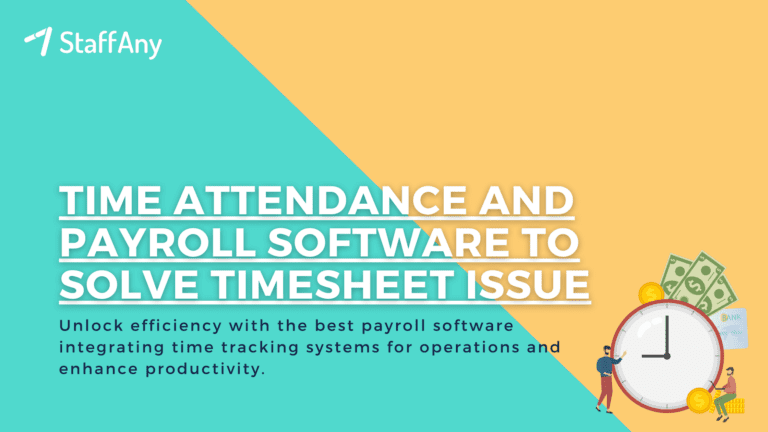Employee performance evaluation is a crucial aspect of managing a workforce. It is a systematic process that involves assessing and measuring an individual’s job performance, with the purpose of determining their strengths, weaknesses, and areas for improvement. The evaluation process is also essential for aligning employee performance with the organisation’s goals and objectives.
In this article, we will explore more about what employee performance evaluation is and its benefits. You will also find some tips for preparing an employee performance evaluation. Let’s find out!
What is Employee Performance Evaluation?

Employee performance evaluation is a systematic process that involves the assessment and measurement of an individual’s job performance. This process aims to determine an employee’s strengths, weaknesses, and areas for improvement, as well as align their performance with the organisation’s goals and objectives.
The performance reviews process usually takes place on a regular basis, such as annually, semi-annually, quarterly, or even monthly and weekly. During the evaluation, the employee’s job performance is measured against specific performance metrics that are relevant to their role and aligned with the organisation’s objectives. These metrics can include productivity, quality of work, teamwork, customer service, and attendance, among others.
Employee performance reviews provide a valuable opportunity for managers and employees to have open and honest conversations about job performance, establish clear expectations, and improve communication. The results of the evaluation can also inform decisions related to promotions, transfers, or other opportunities for employee growth and development within the organisation.
Read more: Understanding Manpower Planning and Its Importance in F&B
What’s the Purpose of Employee Evaluation Process?
Employee performance review process serves several important purposes within an organization, contributing to the overall effectiveness of the workforce and the achievement of organizational goals. Here are the key purposes of employee evaluations:
1. Performance Feedback
Employee evaluations provide employees with feedback on their performance, including their strengths, areas needing improvement, and areas where they excel. Constructive feedback helps employees understand their performance in the eyes of the organization and enables them to make necessary adjustments to enhance their productivity and effectiveness.
2. Goal Setting and Alignment
Evaluations allow managers and employees to set clear and measurable goals for the future. By aligning individual goals with organizational objectives, employees understand their roles in contributing to the company’s success. Clear goals provide motivation and direction for employees, helping them stay focused on their priorities.
3. Professional Development
Evaluations identify areas for improvement and skill development. Based on evaluation results, training and development programs can be tailored to address specific needs. Employees can acquire new skills and knowledge, enhancing their expertise and contributing more effectively to their roles.
4. Recognition and Appreciation
Employee evaluations offer an opportunity to recognize and appreciate employees’ hard work and achievements. Acknowledging accomplishments boosts morale, reinforces positive behavior, and encourages employees to continue performing at their best. Recognition can be a powerful motivator, fostering a positive work environment.
Read more: 15 Employee Engagement Activities to Keep Them Motivated
5. Identification of High Performers
Evaluations help identify high-performing employees within the organization. Recognizing and rewarding top performers can foster healthy competition, inspire others, and encourage a culture of excellence. It also helps in talent management and succession planning by identifying potential leaders and key contributors.
6. Feedback Loop
Employee evaluations create a feedback loop between employees and management. Employees can share their concerns, suggestions, and aspirations with their supervisors during evaluations. Open communication strengthens the employee-employer relationship and enhances overall organizational communication.
7. Performance Improvement Plans
If an employee’s performance is below the desired level, evaluations provide a basis for implementing performance improvement plans. These plans outline specific areas for improvement, set goals, and establish timelines for achieving the desired outcomes. Regular evaluations monitor progress and support employees in reaching their potential.
8. Legal and Documentation Purposes
Performance evaluations serve as legal documentation of an employee’s performance, which can be crucial in cases of disciplinary actions, promotions, demotions, or terminations. Comprehensive and accurate evaluations provide evidence of an employee’s performance history.
9. Decision-Making
Performance evaluations often influence decisions related to promotions, salary adjustments, bonuses, and other forms of recognition or rewards. Objective performance assessments guide fair and data-driven decision-making processes within the organization.
In summary, employee evaluations are essential tools for fostering employee growth, enhancing organizational performance, and maintaining a positive workplace culture. When conducted effectively, they contribute to employee engagement, job satisfaction, and overall organizational success.
Read more: Employee Management System: Definition and Importance
The Benefits of Evaluating Your Employees’ Performance

Employee performance evaluations can provide numerous benefits to organisations, including:
1. Improved Performance
By regularly evaluating employees’ performance, organisations can identify areas for improvement and help employees enhance their skills and abilities. This leads to improved performance and increased productivity, which benefits the organisation as a whole.
2. Better Communication
The evaluation process provides an opportunity for managers and employees to have open and honest conversations about job performance. This helps establish clear expectations and improves communication, leading to a more positive work environment.
3. Improved Employee Engagement
When employees understand what is expected of them and receive feedback on their performance, they are more likely to be more engaged in their work. Evaluating employee performance helps keep employees motivated and focused, leading to higher job satisfaction and engagement.
Read more: 13 Effective Employee Retention Programs to Keep Your Best Talents
4. Increased Retention
Organisations that value their employees’ contributions and provide opportunities for growth and development are more likely to retain them. By regularly evaluating employee performance, organisations can ensure that employees feel valued and supported, leading to increased employee retention.
5. Better Talent Management
Evaluating employee performance can help organisations identify high-performing employees who can then be considered for promotions, transfers, or other opportunities for growth within the organisation. This leads to better talent management and a stronger workforce.
6. Improved Decision-Making
The results of employee performance evaluations can provide valuable information that can inform decision-making related to promotions, transfers, training, and other opportunities for employee growth and development. This leads to better-informed and more effective decisions.
Read more: Understanding the Importance of Human Resource Planning
Factors to Consider During a Performance Evaluation
Employee performance evaluations are essential for providing feedback, setting expectations, and recognizing achievements within an organization. When conducting performance evaluations, several factors should be considered to ensure a comprehensive and fair assessment of an employee’s performance. Here are the key factors to consider during an employee performance evaluation:
1. Job Knowledge and Skills
Assess the employee’s understanding of their role, industry knowledge, and the skills necessary to perform their job effectively. Consider whether they have the required expertise and if they continuously update their skills.
2. Quality of Work
Evaluate the quality and accuracy of the employee’s work. Consider the consistency, attention to detail, and thoroughness of their output. Assess whether their work meets the organization’s standards and expectations.
3. Productivity and Efficiency
Consider the employee’s ability to manage their workload efficiently. Evaluate their productivity, time management skills, and ability to meet deadlines. Assess how well they balance quantity and quality in their work.
4. Initiative and Innovation
Evaluate the employee’s proactiveness, initiative, and willingness to take on additional responsibilities. Consider their ability to generate new ideas, problem-solve, and contribute to process improvements or innovations within the organization.
5. Communication Skills
Assess the employee’s communication skills, both verbal and written. Consider how well they convey information, collaborate with colleagues, and interact with clients, customers, or stakeholders. Evaluate their ability to actively listen and provide clear, concise messages.
6. Teamwork and Collaboration
Evaluate the employee’s ability to work well with others. Consider their contributions to team projects, willingness to assist colleagues, and ability to resolve conflicts constructively. Assess their collaboration skills and whether they contribute positively to the team’s dynamics.
Read more: How to Establish Effective Workplace Communication?
7. Adaptability and Flexibility
Consider how well the employee adapts to changes in the workplace, such as new processes, technologies, or organizational structures. Evaluate their ability to handle change, learn new skills, and adjust to evolving job responsibilities.
8. Attendance and Punctuality
Evaluate the employee’s attendance record, including punctuality and adherence to the organization’s attendance policies. Consider their reliability and consistency in attending work and meetings.
9. Customer Focus
If applicable to the role, assess the employee’s focus on customer satisfaction. Consider their ability to understand customer needs, provide excellent service, and maintain positive relationships with clients or customers.
10. Goal Achievement
Review the goals and objectives set for the employee and assess their progress toward achieving these goals. Evaluate whether they meet, exceed, or fall short of the established performance targets.
11. Professional Development
Consider the employee’s commitment to their professional growth and development. Evaluate their participation in training programs, certifications, workshops, and other activities aimed at enhancing their skills and knowledge.
12. Managerial and Leadership Skills
If the employee is in a managerial or leadership role, assess their ability to lead, motivate, delegate, and mentor team members. Evaluate their effectiveness in managing and developing their team.
When evaluating employees, it’s essential to provide specific examples and feedback to support your assessments. Additionally, involving employees in self-assessments and encouraging them to set their own goals can contribute to a more comprehensive and meaningful performance evaluation process.
Read more: 11 Fair Ways on How to Evaluate Staff Performance Effectively
Streamline Your Employee Performance Evaluations with StaffAny
StaffAny’s Time Attendance System streamlines the process of tracking time and attendance by providing real-time, organised information directly to HR. It uses advanced cloud technology through employees’ mobile devices, eliminates hardware maintenance and offers safe and flexible options such as geofencing, QR codes, and GPS.
The system ensures accurate tracking of actual working hours, prevents unauthorised clock-ins and auto-clockouts, reduces labour costs, and eliminates time fraud. It enables clock-ins at multiple sites, centralises attendance data, and integrates with data tracking software for real-time employee attendance reports and easy schedule management.
With all of those features and more, StaffAny’s employee management software provides a complete solution for managing the needs of today’s modern workforce, seamlessly integrating your HR and operational needs.
Whether you’re a small business or a large corporation, StaffAny is the best employee management system for streamlining your HR processes and improving your overall business performance. So why wait? Start using StaffAny today and experience the benefits of a connected and efficient workforce!











